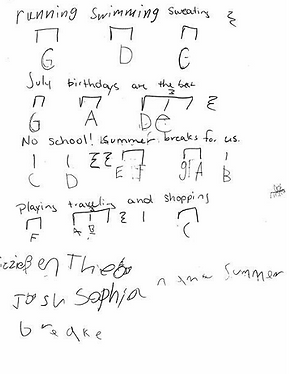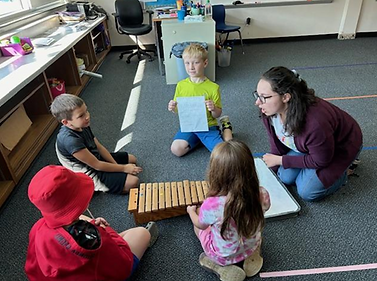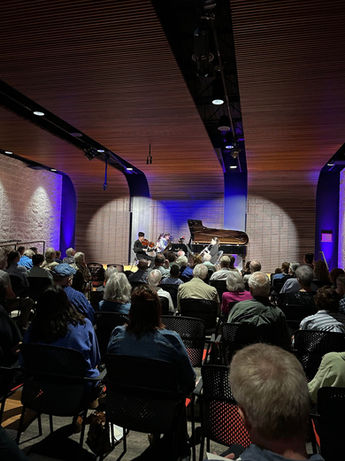Kids &
Counties

Painting by Lory Williams Winford
Kids and Counties
In Brown County we bring music to children. We bring music to the schools to teach kids the importance of listening, creating, and communicating through music. We have also produced concerts for children for the important work of creating the next generation of listeners. Music can be written by and for anybody- even kids.
We go beyond Brown County. Our mission is to bring music of the highest caliber to counties in rural Indiana. We’d love to hear from you.
More details: Contact Annie Hawk, 440-864-2345.
Brown County Kids Compose Music!
By Jan Holloway
Brown County Democrat
It started with a hug.
The third-grade students at Helmsburg Elementary School in Brown County had bonded with music
educator Debbi Ponella.

Words are rhythm
In working with kids, in her Kids Compose program, Ponella often starts with the spoken word. When kids say a phrase, repeat it, talk back and forth, they discover rhythm. Intonation. She starts with their world and teaches them to invent from that place. Kids took turns standing at the front of the class in groups of four. Ponella asked: “What is your favorite animal?” Kid: “A wolf.” Ponella: “What’s similar?” “A dog.” Ponella: “What else?” “A fox.” She clapped it back to them–one short syllable each: Wolf. Dog. Fox. Ponella: “What’s different?” Kid: “A kitten.” Ponella: “Clap each one.” Kids clapped: Wolf. Dog. Fox. Kitten. They saw the rhythm of different syllable counts. Ponella: “Now mix yourselves up.” Kids clapped: Dog Fox Kitten Wolf. They played with it: Tiger. Dog. Piglet. Hippo. Hippopotamus! Penguin! S-s-s-ssnake! They heard their suggestions turn into rhythmic phrases. As they chanted the short and long animal words, leaning into the short and drawn-out syllables, they learned about rhythm. What it’s made of. How you can mix it up. Play with it. This is the beginning of music.
Music is fundamental
Cellist, music educator, and Kids Compose creativity cultivator Debbi Ponella launched her 20th year of Kids Compose, excited to be doing it in Brown County, thanks to a ChamberFest educational outreach grant of $7,500. Ponella led kids through what music is made of. We watched as she led third graders in Sprunica, Van Buren, and Helmsburg Elementary Schools through the fundamentals of music—elements they discovered were innate in their own selves. Rhythm. Melody. Intonation. And ideas that inspire music. According to Ponella, “Everyone has a relationship with music. Kids on the playground chant songs or rhymes. People sing in church. There’s folk music. Kids bang on kitchen pots. A mother rocks her baby. We all do something. There’s intonation, there’s rhythm everywhere. Music can apply in so many ways across kids’ lives. They’re breathing together, playing together, and in so doing they’re learning to work with people, learning to collaborate, to think, to listen.” “I see music as finding a way to relate. Music is a way you can express yourself, a way you can learn. I see kids with all different interests connect to a musical expression. It’s a way to connect to the creativity inside them. If speaking up in class is uncomfortable, music can give them another way to express themselves.”
Kids compose
In four-week sessions at each school, kids learned about the basic elements of music and the places they hold in our everyday lives. They learned about individual instruments—their timbres, registers, and how they sound together–and create a melody. Kids worked together in groups, developing ideas about things they liked. Summer break. Favorite foods. Foxy—chica bonnie coming for you. They looked at pictures they had drawn. All these became topics to set to rhythm, then music.

“Summer Break” – the score


“Summer Break” takes musical shape
Kids work on “Summer Break”
Ponella asked: “How do you put music to a picture, to put shape to melody?” One group had drawn falling leaves. Ponella asked: “Are things going up or down?” “Down,” they said. “Leaves can also fall up,” said one kid. They thought about it, saw leaves swirling up and down and around in a breeze. Ponella: “What does that movement sound like? Decide on the notes. Play them on the xylophone. Decide if you like how that sounds. Or make it sound a different way.” On the xylophone, kids went up and down, down and up again, with the movement of the leaves.
The next week, instruments came to class: viola, clarinet, trumpet, trombone, harp, and cello. Kids heard expert musicians play on different instruments the melodies they had written. Ponella asked what instruments they liked best. Opinions were all over the board. Flute. Viola. Trumpet. She supported their diverse ideas. “It can be hard to decide. Everyone likes different instruments.”
This is how music is created. Start with an idea. A picture. Create a rhythm. Imagine a melody. Expand on that musical core. Score it for instruments you like. Each melody became the inspiration for a piece commissioned by a Jacobs School of Music graduate student in Composition. So, just like real composers, kids heard their own melodies form the heart of longer musical compositions.


One group melody gets applause

Kids listen as their tunes become performances
Debbi and kids work on melody
Life lessons through music
Ponella told the classes: “You worked together really well. You added your voices to the rhythm and the story. Different people contributed in different ways. And every contribution mattered.” In the process of working in groups to create one whole, kids learned that their opinions mattered. They learned to listen and respect others’ voices and ideas. Many layers of life lessons were part of their act of working on a common expression.
At a final assembly, kids heard each of their compositions performed by the Kids Compose chamber group. With each performance, its composers stood, and listened, enchanted. This was music they had written together, each individual idea woven into the whole. The credit belonged to the group. You could see their amazement, joy, and pride. Look what we did!! They gave each other high-fives. They began to see what Ponella believes, that “music and creativity as well as their intersection with music composition, is inherent in all humans.”
According to one kid, “Creativity is being awesome with your brain.” At the last class, Ponella asked, “How many of you will make music on your own?” Hands went up.
Mooch the Magnificent

A Children's Opera in One Act
ChamberFest Brown County is delighted to present the children’s opera “Mooch the Magnificent” at 12:30 pm on August 22 at Parkview Church, Nashville.
Mooch the Magnificent is a 40-minute opera on a libretto by Scott Russell Sanders.
Synopsis:
The opera takes place in a zoo of robot “animals” in a dome-covered city that is part of a worldwide network of such cities, connected by travel tubes, sealed off from the outside. The time is the late twenty-first century, after humans, afraid of the wild outside, have moved indoors.
The setting is a futuristic zoo populated not by animals but by robots in animal form. Mooch, an orphan girl, convinces the zookeeper to hire her to fix the robots when they break down, but she secretly reprograms them to be increasingly wild.
Composer and Conductor: Lauren Bernofsky
Director: Ansley Valentine
Cast:
MOOCH: Sara Dailey, soprano
UNICORN: Danielle Long, mezzo-soprano
LION: Ben Rardin, tenor
ORLANDO: Steven M Warnock, baritone
Instrumental Ensemble:
Susan Archibald, piano
Keith Northover, clarinet
Eunice Kim, cello
Ford Smith, percussion











